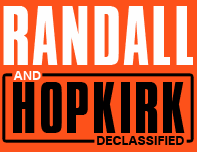|
Decades ago, when viewers
were less technically aware about the 'magic of
television', we would sit back to enjoy our
favourite programmes on the three or so channels
with little care or knowledge about how those moving
pictures actually ended up on our screens.
Therefore, this article which is part knowledge,
part educated guesswork, is designed to show how a
series like Randall and Hopkirk (Deceased)
and other film productions, were broadcast.
Most people of yesteryear were
familiar with the concept of film projection, having
no doubt seen a few things projected at school or
college (quite possibly allowing close up
examination of the projector) as well as of course
the cinema. So, how did a film end up on television?
Was it also projected onto some sort of screen? The
answer is of course, no. This is where a different
type of equipment called a telecine would be
employed to turn the film image into a video signal
and it would be much larger than a projector,
requiring several 'cupboards' worth of analogue
electronics. In the era in question, the main
machine of choice for a broadcaster would be a Rank
Cintel telecine, with the improved twin-lens version
being designed around 1964.
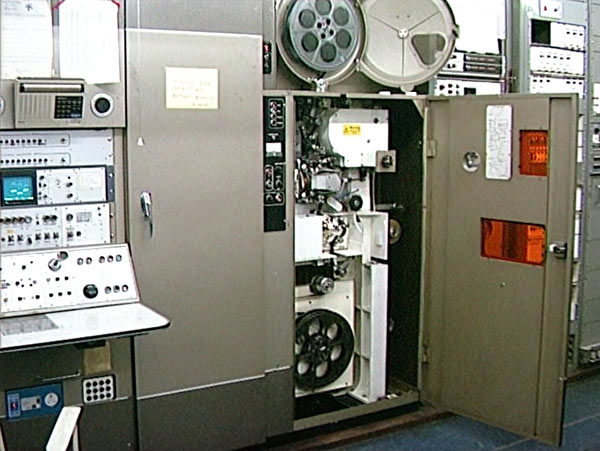
Rank Cintel 1960s 35mm Twin Lens Telecine
Image © Jonathan Wood, 2023
The purpose of such a device
was to illuminate a frame of film and create two
video fields from that frame in order to satisfy the
requirements for the 50Hz UK PAL TV system. Instead
of the light source being some sort of lamp, the
film was illuminated with a scanning spot on a
cathode ray tube, in the same way the picture was
made up on a CRT Television. Also, the film would
run at a constant linear speed rather than being
paused in the gate like a projector. In the Rank
Cintel telecine, twin-lenses were used in
combination with the CRT and the film movement to
scan each film frame twice. However, this is where
some fudging came into the equation, which has been
referred to in more recent years as PAL speed-up.
The main shooting speed for film production is 24
frames-per-second (fps) and anything destined for
international sales would most likely follow this
designation – as did ITC productions. However,
maintaining 24 fps while converting to 50Hz video
was something of a headache. It could be
accomplished with telecine machines employing a
polygon prism but at the expense of picture quality
as frames would be merged. It was far simpler to run
the film 4% fast at 25 fps instead, thereby aligning
each film frame with each video frame. This would of
course affect the audio side as well with everything
being increased in pitch by a semitone.
The desire for international
sales meant that series like Randall and Hopkirk
(Deceased) were shot on 35mm film, the same
gauge that most feature film productions used,
although this wouldn't always be the case once the
1970s came along. Also, at this time, if something
was shot entirely on film it was invariably finished
on film. That is the complete programme edited and
assembled, with printed titles and captions,
producing a finished print, often with a combined
optical (com-opt) soundtrack even if the master
audio source was magnetic. By the late 1960s,
videotape technology had been around for a decade in
terms of being a usable broadcast medium, but it was
still an expensive format to use. Therefore, if a
show originated on film, it would be broadcast
directly from film rather than being transferred to
2-inch videotape beforehand.
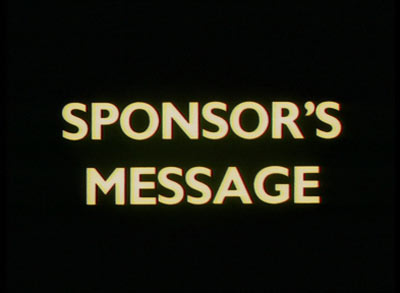
Image © Network, 2016
Master film reels – that is the
original negative and back-up elements such as an
inter-positive – usually come in 1k lengths, about
1000ft of film, which equates to roughly 10 minutes.
These would also include captioning at the fade
points such as “Sponsor's Message”, “Insert
Commercial”. So, a 50-minute episode would require
five, sometimes six master reels depending upon how
the action was split up. These split points would be
chosen by the editors to avoid places involving
continuous incidental music. For direct film
transmission, the BBC would make up the printed 1k
reels into several double length spools for a
feature film or two larger 25-minute spools for
a TV series episode. This compiling exercise would
not only remove any commercial break captioning in
the case of television productions, but quite often
fades to black as well.
Two telecine machines would
then be used as a duplex pair, with a triggering
point to change over the output signal from one
telecine to the other at a reel changeover, in order
to produce a seamless broadcast. For a feature,
these changeovers would flip-flop back and forth
between the pair of machines, much like the classic
cinema projection did. The transmission would be
rehearsed a couple of days prior in order to check
the condition of the film materials and find some
basic colour settings as well as audio levels. A
rehearsal sheet was filled in so that when it came
to the actual transmission, the telecine machines
could be aligned accordingly about an hour before
the broadcast. The BBC, of course, would not screen
ITC film series until the 1990s, but their practices
with film materials of this type were largely
reflected across the industry. In commercial television, the advert
breaks would mean the seamless switching between
machines wasn't always required, especially for a 50
minute show comprising of two UK commercial breaks.
For the original 1969-70 Randall and Hopkirk
broadcasts, it is possible that the commercials –
which were also 35mm prints – were physically
spliced directly into the programme material and
broadcast from the same reel. This would have been
in addition to the insertion of the graveyard
titles, which replaced the more elaborate Chambers
and Partners sequence within the master materials
(see
Features: Only You Jeff!).
When looking at the initial
broadcast run of the series on ITV, it tells us
several things. ATV started showing the series first
and they would have run prints directly on their
telecine machines for broadcasts starting on Friday
19th September 1969 at 7.30pm. For the first four
weeks, the adjoining region to the west, HTV did the
same, but, rather than running their own print, it
is much more likely they just took a line feed from
ATV until moving the series' time slot in their
region to Sunday at 3.45pm. Similarly, Westward
Television would have taken a line feed too but
lasted an additional week compared to HTV, until moving their
timeslot some 25 minutes earlier, with the entirety
of their broadcasts being duplicated by Channel
Television who had limited facilities of their own.
The Granada region stayed with ATV's broadcasts for
eight episodes (as did Ulster) before they dropped
the series for a couple of months, but Yorkshire
stuck with ATV right up until Christmas. In London
and the Southern regions, it appears the prints ATV
ran first were then sent down to LWT for rebroadcast
two days later on a Sunday, then eventually sent
onto Southern for showing a couple of weeks later.
Once a region deviated from ATV's time slot, they
would have had to run prints themselves which would
have caused extra wear and tear to the materials. As
odd as it sounds now, no videotape recording would
have been employed as a method of timeshifting the
broadcasts for other regions by recording ATV's
output. For a production wholly on film, it wouldn't
have been deemed economical to tie up VT equipment
and tapes that way – it would have been considered
better to just broadcast directly from film.
BBC transmission prints were marked with a red label
stating, “This is a transmission print, it must not
be marked or cut”. However, once a series on film
started its journey around the various ITV regions
to cater for different broadcasts, each region may
have decided to take their commercial breaks in
different places. This would have resulted in the
cutting and rejoining of the film prints (often
losing a frame or two) on top of
the additional usage, which meant that having 'done
the rounds' they were going to be fairly dirty and
have some obvious joins. However, this isn't
something that was really noticed by the average
viewer or indeed was particularly worried about back
in the day. In addition, these live telecine
transmissions had people grading 'on the fly',
meaning they had to adjust levels and colour as the
programme went out live, based upon what they saw
and in real time. The result of this can sometimes
still be seen on film inserts in unrestored archive
video productions, where the colour and contrast
vary on a shot as live adjustments were made. Audio
wise, only the combined optical track of the print
was used as it would have been an extra headache to
sync up a separate magnetic track, especially if
commercials were also being spliced in.
The lack of an ITV fully networked broadcast
underlines the way ITC product was treated by the
big five companies, although of course ATV would
usually debut and promote any ITC product well for
the Midlands. The standpoint of the other companies
– Thames, LWT, Granada and Yorkshire – was that
ITC's film series were generally viewed as
bought-in, non ITV material, much like any feature
film or American TV series, except even less so,
which in retrospect was definitely a mistake. Unlike
today, there was also more individuality between the
regions regarding schedules and apart from the
national news, main feature films and prime ITV
series, the programme line-ups could be quite
different from one region to another. Sometimes,
even if they appeared to be the same, with regard
to ITC product, it was often a different episode being
shown. So, for Randall and
Hopkirk (Deceased), if you happened to
live in the overlap area between London and Southern
regions in late '69, then by tuning into the aerial
signals coming from the Crystal Palace and Rowridge
transmitters, you would have had a choice of episode
viewing on a Sunday evening with the two companies
running different film prints.
It can be appreciated that from
the set-up of the separate ITV companies, if a film
series was not fully networked, then the film
materials themselves would have had a lot more wear
than any equivalent prints the BBC used during the
same time period. However, one kind of damage that
sadly always occurred on a 35mm prints run on the
1960s era telecines during rehearsal and
transmission was scratching. Before going on air,
each reel would be run in about half a minute for
the initial grading levels to be set, then the
telecine would be stopped and run backwards to the
leader. When the machine slowed down, two
stabilising rollers either side of the gate that
made contact with the film would slow down at a
different rate compared with the linear motion of
the film. Consequently, the print base would be
scratched, producing noticeable fine vertical black
lines within the first minute of most film reels.
Despite all this, I'm sure the original prints would
have been utilised for live telecine broadcast
throughout the 1970s, although by the end of that
decade they would have been in quite a state, having
been constantly chopped about – and the Eastman
colour stock would have faded to a degree.
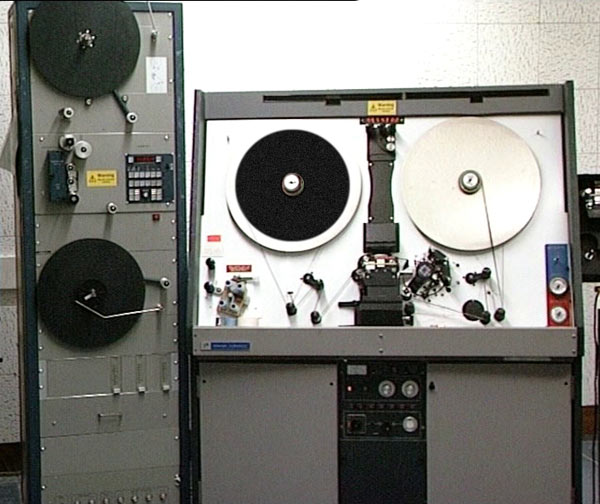
Rank Cintel MkIII telecine with sepmag bay on
the left
Image © Jonathan Wood, 2023
By the time the last repeats
finished in 1977 and the series disappeared from our
screens for a good while, the BBC had bought one of
the newer Rank Cintel telecine machines called the
MkIII. Rather then being upright like the previous
generation of machine, it was designed to look more
like a VTR, with the film reels side by side, and it
was capable of running different film gauges with
interchangeable gates. It could also run film on
spools or plastic cores and, unlike the earlier
telecines, it did not drive the film through with
multiple sprocketed rollers. Instead, it employed a
friction drive with tension arms keeping the film
taut through the gate and over a capstan coated in a
rubbery compound. It also had the big advantage of
being able to fast wind the film forwards or
backwards, whereas the old telecines could only run
at play speed in either direction. There were some
downsides to this new equipment, one being the more
compact electronics had a poorer signal to noise
ratio than the previous generation. Also, as the
transport mechanism relied upon maintaining a
certain tension, if a dodgy film join came along
which was slightly sticky, it could quite easily
cause a tension arm to go out of position and bring
the whole thing to a grinding halt. Therefore,
despite the BBC buying more of the MkIII machines,
ending up with eight of them by the late 1980s, they
continued to use the older generation of telecine
for live film transmissions right up until the end
of their use in November 1988. This was mainly
because those machines, with more sprocketed
rollers, would just keep churning along unless the
film print actually broke. ITV on the other hand
obviously embraced the newer technology for
broadcast rather more, which occasionally caused
problems. For example, their transmission of From
Russia With Love in December 1985 came to an
abrupt stop for several seconds during the train
sequence just after Bond smacks Tatiana on the
behind!
The
following summer, repeats of Randall and
Hopkirk (Deceased) began to emerge once
again on ITV, with each region running the
series as a daytime or late night filler. By
this time, the main videotape format for
broadcast use had shrunk from 2-inch to 1-inch
wide tape, and it was therefore somewhat cheaper
to use. That's not to say though that 2-inch was
redundant, being used by the BBC as a
direct-to-air format until the end of the 1980s.
However, most ITV regions would still have had
their legacy Telecine departments, so if air
time could be filled by utilising those
facilities, freeing up VTRs for recording and
editing tasks, then that route would be
considered advantageous, especially for an
archive repeat. As the 1980s progressed, some
film programmes and features would of course get
broadcast from videotape, having been previously
transferred. However, even during the last
summer of direct-to-air film broadcasts (as far
as the BBC were concerned), there were still
times such as 8.00pm on Saturday 18th June 1988,
when both networks carried live transmissions
from the telecine department, with a TV movie on
BBC1 and a feature on BBC2.
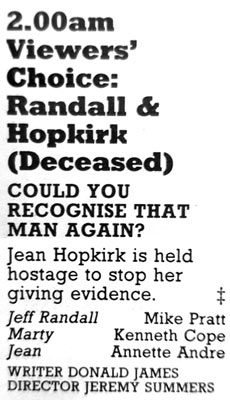
A TVTimes listing for the TVS ITV region
Image © TV Times, 1988
With a new, fresh set of 35mm
prints having been made (now featuring the Chambers
and Partners titles), two years of repeats commenced
around the ITV regions, being kicked off by Granada
in 1986 and finishing up with TVS (Television South)
in 1988. I feel confident that the majority of these
showings would still have been directly from film.
TVS carried most of their Randall and Hopkirk
repeats in their Late Night Late strand which
also repeated Gerry and Sylvia Anderson's
UFO around the same time. Both of these series
had apparently been voted for by TVS viewers, hence
their listings had “Viewer's Choice” preceding the
series title. During the broadcasts, there were a
couple of examples where the break caption cards (an
electronic slide) were held far longer than the
usual 5 seconds or so. At the end of one of the
UFO episodes, the in-vision continuity announcer
apologised for the hiatus in the middle, saying it
was down to them not being sure if they had the
reels in the right order! The majority of this last
ITV airing from TVS did start out as transmissions
directly from film, but towards the end of the
series' run (similarly with UFO) they changed
to transferring to videotape in advance and then
broadcasting those recordings. By the 1990s though,
things had most definitely changed.
Whereas the early days of VHS
home video had mainly revolved around timeshifting
your favourite programmes and renting the latest
blockbuster, by the late 80s there was additional
bias towards buying and owning pre-recorded
favourites. These 'sell-through' tapes weren't so
ridiculously priced – unlike rental titles – and,
via labels like Channel 5 Video, some ITC series
like UFO were available. However, Randall and
Hopkirk (Deceased)
was completely absent, even in
the compilation movie format going back to the
Precision Video days. By early 1992 though this had
changed, with ITC series having started to be
released in their original episodic versions by ITC
Home Video, with two episodes per VHS tape and a
pair of volumes released together. Broadcast wise,
Channel 4 began a 13-part series of theme nights
called TV Heaven hosted by Frank Muir. Each
instalment would concentrate on a different year and
the ninth episode looked at 1969. Being featured
that week was the first episode, My Late Lamented
Friend and Partner, in what would have been its
first network broadcast. Instead of a film print,
the episode was supplied by ITC Entertainment Group
to Illuminations Productions as a video recording,
no doubt a dub of the home video master. However,
they made a change to this copy, sneakily re-editing
the end titles of the show, shortening each credit
slightly in order to include a little free plug at
the end. They added a new company production credit
and also one promoting ITC Home Video Ltd, which
were releasing the first wave of VHS tapes. The
TV Heaven theme nights were edited and broadcast
on 1-inch videotape.
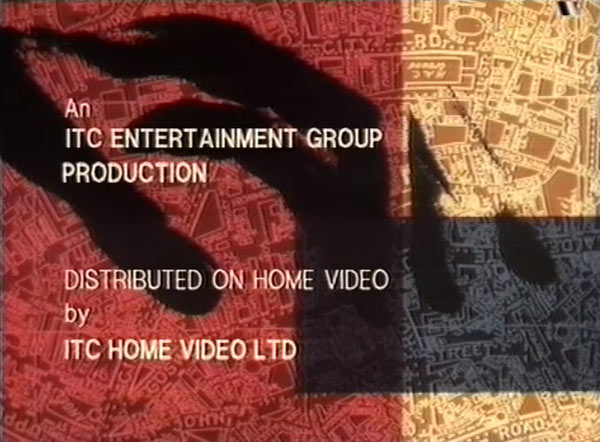
The final caption added for the TV Heaven
broadcast of 4th April 1992
Image © Illuminations / ITC Home
Video, 1992
Two years later in 1994, yours
truly was looking at the film shelves in the
telecine area at BBC TV Centre, and was amazed to
find some 35mm prints of Randall and
Hopkirk (Deceased). After making some enquiries,
I discovered that the full series had been bought
for broadcast. The person responsible for this was
most probably TV executive and new controller of
BBC2, Michael Jackson, for when it came to an
internal promotional launch of the new BBC2 Autumn
schedule, at one point Michael donned a white suit
and told us we'd be seeing an old friend again.
Each episode print comprised of
three unedited 35mm reels, that is the five or six
1k reels had been compiled into three for easier use
by the Programme Acquisition film department.
However, they had not been cut in terms of break
points as this was no longer required since live
film transmissions had ceased in 1988. Instead, any
editing to form the complete programme would be
performed on the transfer from film to tape, the
video format being D3 - a digital PAL half-inch
cassette system made by Panasonic which had been
adopted by the BBC for broadcasts three years
before.
As I had seen the full series
several times thanks to my TVS recordings, I had
noticed that the usual broadcast order appeared to
be all over the place. There was a world of
difference over the 14-month production period from
the earlier produced episodes with a somewhat more
serious tone and a dark suited Randall, compared to
the jauntier later ones with tan leather jackets and
a big-haired Jeannie. Therefore, I had tried to work
out a rough production order based on titbits of
information as well as personal viewing notes. When
I saw the programme numbering that the BBC had
assigned the episodes I could see they were similar
to previous airings, in other words somewhat
haphazard. Late episodes such as A Disturbing
Case were planned to appear very early in the
run and other episodes where Marty pops in and says,
“Don't say anything, Jeannie will think you're
talking to yourself,” were placed way too far down
the order, making no sense in terms of the
progression of the series. I explained this to the
programme executive in charge and they decided they
would follow the order I recommended. By the time
these discussions took place, the three initial
episodes had already been put onto tape by my
colleagues. However, I was then assigned to transfer
the remaining 23.
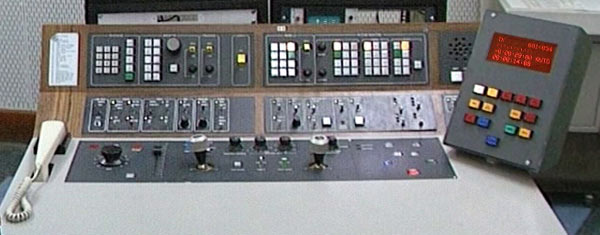
BBC-designed grading desk and Digi-Grade panel
(right)
Image © Jonathan Wood, 2023
Each episode was allotted
approximately four hours to grade, edit and
transfer, with each reel first colour graded before
being rewound and then edited across to the D3 VTR,
pulling up the commercial break points in the reels
whilst retaining the fades. The grading settings
were stored using the BBC's in-house designed
platform called Digi-Grade, which had a simple dot
matrix display to indicate timings and settings,
allowing for shot-by-shot adjustments as well as
linear changes. Another factor during these
transfers was an attempt to help any of the times
that Marty appeared and disappeared, if required.
With the actors having been told to “freeze” and the
action later continuing with the appropriate edit in
the negative, all would generally be well if the
camera was locked off. But if the original framing
moved slightly there would be a tell tale shift of
the image on the edit point which rather spoilt the
overall effect. It was these examples where I would
also program a picture position change on the
telecine in order to counteract any camera movement
either side of the edit to help sell the effect.
On the audio side of things, as
per the original 1969, 1970s and 1980s broadcasts, a
comopt track (combined optical) was the source, even
though original studio takes and the subsequent
editing / dubbing stages of a film production all
utilised magnetic recording mediums, with the final
mix being recorded onto either a 35mm sepmag
(separate magnetic) track or a quarter-inch tape
with locking pulses/tone. Either of these would then
be used as an audio source for the optical sound
printer in order to create an optical track. The
downside being the frequency response of an optical
track starts to fall away rapidly above 5kHz and is
therefore never going to be a match for its magnetic
counterpart that may contain frequencies up to 15kHz
for an archive film. However, because a comopt
soundtrack is part of the print, running alongside
the picture frames, it's quicker and simpler to use
even if it is of a lesser quality and, in the case
of these transfers, no alternative audio source was
supplied.
As with any tape created for
transmission, the video recording contained an
identification countdown clock preceding the
programme material. By the time of these 1990s
broadcasts, this was derived from an electronic
device which would produce a simple 30-second
countdown with a fairly basic white font on a black
background. I decided with these transfers to pep
things up a bit and utilise the clean frames during
the original end titles to produce a background that
changed until reaching 10 seconds on the clock (the
standard cue point) along with some of the original
logos. The image below shows the different stages of
the master clock I created, over which I would add
the BBC programme number assigned as well as the
episode title.

Episode-less countdown clock
Image © BBC Resources, 1994
Having had an interest in the
classic shows of the 60s and 70s, even when they
weren't that old, I seemed to have taken a path with
regards Randall and
Hopkirk (Deceased). After I had seen a brief
clip of the show in the Noel Edmonds hosted Telly
Addicts quiz, I wanted to see more. Then in
1987, on the way back from a holiday in Wales, my
family popped in to see some relatives and armed
with a new VHS tape, I commandeered their video
recorder for an hour that afternoon. The reason for
this action was that I had noticed HTV were running
an episode of the series that day and so I saw my
first-ever complete episode, which turned out to be
one of the last produced, Somebody Just Walked
Over My Grave – and I really enjoyed it. Then
the following year, my local station TVS broadcast
the whole lot, which I dutifully woke myself up to
record, even when it was on at 2.00 in the morning.
Fast forward some six years and I found I was making
the transfers for most of the episodes for a full
repeat on BBC 2. Those transfers had a couple of
airings on the BBC, although the second one was far
less prestigious, being used as a sporadic daytime
filler. Indeed, the transmission breaks in the 1996
showings meant the broadcast rights actually ran out
before the last episode could be shown, with the
satellite channel Bravo running the series at the
start of July but utilising the ITC Home Video
masters. In the year 2000, the BBC D3 masters were
sent to Carlton (then current owner of the ITC
library) to be used as the source for most of their
DVD releases. However, in the sending of the tapes,
one of them did a Marty and disappeared!
The D3 tape of the episode
Whoever Heard of A Ghost Dying? had somehow
vanished and couldn't be located either at the BBC
or Carlton's video department. Therefore, in order
to complete the series, a new transfer of that
episode was requested and this is where things went
up a notch for the first time. Where the original
prints used six years before had ended up I'm not
sure, but for whatever reason it was decided to work
from an inter-positive element this time around – a
higher quality picture source. Not only that, BBC
Post Production had acquired a new telecine machine
in 1998 called a Spirit Datacine. In comparison to
the Rank Cintel MkIII machines (even by the early
1990s they were somewhat past their best) this was
like changing up from Marty's Austin Mini to a Rolls
Royce!
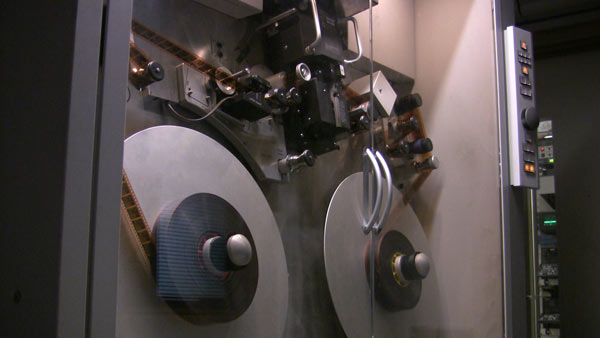
The BBC's Spirit Datacine running 35mm master
material
Image © Jonathan Wood, 2023
Furthermore, the grading system
in use with the telecine was now a commercial
product with more comprehensive grading tools,
running on a computer with a VDU and large control
panel. If that wasn't enough, the VTR format had
also progressed from Panasonic's D3 to Sony's
Digital Betacam, the latter providing component
recording. In layman's terms, this means the colour
signal in an image is recorded separately which
results in a higher quality picture. Add to all that
the fact that yours truly had amassed rather more
experience with grading, having over ten years under
my belt by this point, and the results – even though
still in standard definition – were a definite step
up in quality. The final icing on the cake was on
the audio side. As an interpositive element carries
no audio, the soundtrack was supplied as a 35mm
sepmag. Once I had loaded the magnetic track and
started the playback, it seemed like cotton wool had
been taken out of my ears in comparison to what I
had heard before: the clarity of the speech and
especially the music was superb!
At the end of that work day,
sandwiched between Christmas and New Year 2000, it
felt like I had achieved something special. It may
have only been a single episode of the series, but
finally it looked and sounded the way it deserved.
Even by this point, those six year old masters had
begun to look a bit tired. Seeing them from today's
viewpoint, turning up on low bit-rate digital
Freeview channels (which only serve to soften the
image even further) they now look pretty dreadful to
be honest. However, that first network showing on
BBC2 in a regular Friday evening timeslot really did
bring the series to a new audience, which often
placed it in the top 10 most watched shows on BBC2.
To have been involved in that in any capacity makes
me feel somewhat proud.
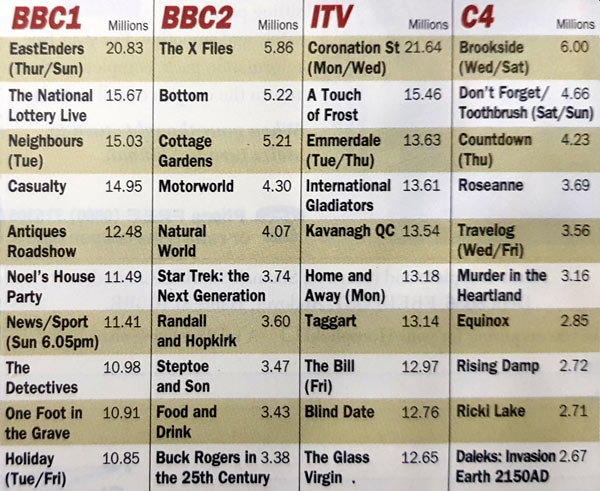
BARB viewing figures, 9th-15th January 1995
Image © BARB, 1995
It seemed that the one-off IP
transfer would be my last work with the series, but
little did I realise that some 16 years later I'd be
lucky enough to have yet another opportunity to
improve the available quality of the series even
further in high definition... but that's another
story!
|
